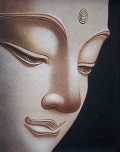Christian wrote: “Buddha Pooja is practicing 8 fold Path”
Of course, that is the ultimate Buddha Pooja.
– However, it also sets the REQUIRED background for many people.
Note: Pooja is usually written in English as Pūjā. So, if you do a search in Sutta Central, for example, you need to use the word “Pūjā”
The Maṅgala Sutta (Snp 2.4) starts with the verse:
“Asevanā ca bālānaṃ,
paṇḍitānañca sevanā;
Pūjā ca pūjaneyyānaṃ,
etaṃ maṅgalamuttamaṃ.
Translated: “Not to associate with fools,
But to associate with the wise,
And to honor those worthy of honor:
This is the greatest good fortune.
The Buddha is the highest worthy of honor, thus Buddha Pūjā is of the highest merits.
There are several suttas in “Therāpadāna” where bhikkhus and bhikkhunis had recited the merits they acquired with Buddha Pūjā done in previous lives. The following is the English translation of one of them:
“Asanabodhiya”
– It has the following verse:
“In the ninety-two eons since
I planted that Bodhi back then,
I’ve come to know no bad rebirth:
that’s the fruit of planting Bodhis.”
It is customary in Asian countries to go to the temple and offer flowers, incense, light candles, and recite the virtues of the Buddha, Dhamma, and Sangha (see below). It is done before sitting down to listen to a discourse by a bhikkhu. That helps sets the right mindset.
The easiest way to do a Buddha Pūjā is to recite the Supreme Qualities of the Buddha. Of course, I normally do all three every day: Buddha, Dhamma, and Sangha.
– See, “Supreme Qualities of Buddha, Dhamma, Saṅgha”
The following booklet could be very useful. It goes into detail about various types of Pūjā. Note that the word Vandanā has the same meaning as Pūjā :
“Vandanā: The Album of Pāḷi Devotional Chanting & Hymns“
